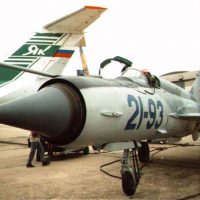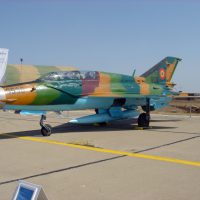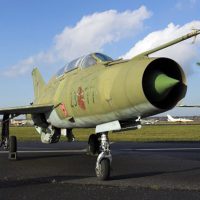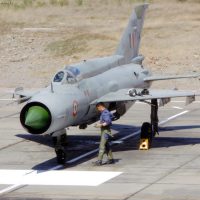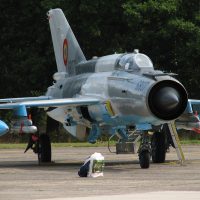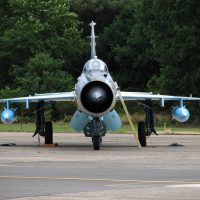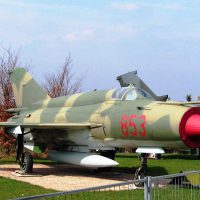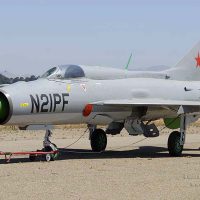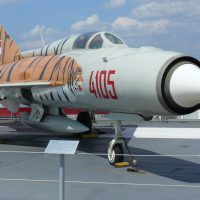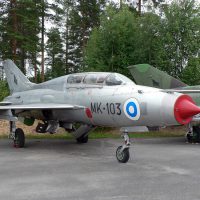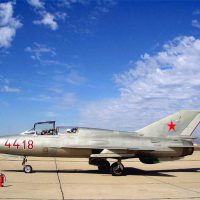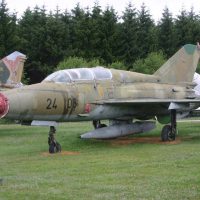Variants
- MiG-21 93
- MiG-21 Bis
- MiG-21 F
- MiG-21 FL
- MiG-21 Lancer A
- MiG-21 Lancer
- MiG-21 MF
- MiG-21 PF
- MiG-21 PFM
- MiG-21 U
- MiG-21 UM
- MiG-21 US
First major production version, also built in the former Czechoslovakia. Still in production in improved forms in China, with Chinese designation J-7. Short-range clear-weather fighter, with radar ranging equipment and a Tumansky R-11 turbojet rated at 42.25 kN (9,500 lb st) dry and 56.4 kN (12,676 lb st) with afterburning (designation of engine given in Soviet press statements as TDR Mk R37F). Two underwing pylons for UV-16-57 pods, each containing 16 57 mm rockets, or K-13 air-to-air missiles, and one NR-30 cannon in starboard side of fuselage (one each side on early aircraft and on the 10 supplied to India). Internal fuel capacity of 2,340 litres (618 US gallons; 515 Imp gallons), plus underfuselage pylon for external fuel tank of 490 litres (129.4 US gallons; 108 Imp gallons) capacity. Small nose air intake of approximately 69 cm (27 in) diameter, with movable three-shock centrebody housing the radar ranging equipment. Undernose pitot boom, which folds upward on ground to reduce risk of ground personnel walking into it. Transparent blister cockpit canopy which hinges upward about base of integral flat bulletproof windscreen. Transparent rearview panel (not on aircraft built in Czechoslovakia) aft of canopy at front of shallow dorsal spine fairing. Large blade antenna at rear of this panel, with small secondary antenna midway along spine. Fowler flap between fuselage and aileron on each trailing-edge, with fairing plate under wing at outer extremity. Small forward-hinged airbrake under fuselage, forward of ventral fin; two further forward-hinged airbrakes, on each side of underfuselage in line with wingroot leading-edges, integral with part of cannon fairings.
Export version of late model MiG-21PF series, with broad chord vertical tail surfaces and brake parachute housing at base of rudder but no provision for SPS or RATOG. About 200 were initially assembled and later built under licence in India by Hindustan Aeronautics Ltd (which see), with the IAF designation Type 77. R-11-300 turbojet rated at 38.25 kN (8,598 lb st) dry and 60.8 kN (13,668 lb st) with afterburning. Suffix letter “L” (Lokator) indicates the installation of Type R2L (“Spin Scan B”) search/track radar, reported to have lock-on range of 10 n miles (19 km; 12 miles) but to be ineffective at heights below about 915 m (3,000 ft) because of ground “clutter”. Can be fitted with GP-9 underbelly gun pack. Identified in 1966.
As MiG-21PFMA, but with higher rated, lighter weight, Tumansky R-13-300 turbojet; gun gas deflector beneath suction relief door forward of each wingroot; entered Soviet service 1969.
Export variant of MiG-21MF; R-11F2S-300 engine; built as Indian Air Force Type 96 by Hindustan Aeronautics, with deliveries from 1973-81.
Basic model of second series of operational versions with mid-fuselage waisted in accordance with area rule and forward fuselage of less tapered form. Intake enlarged to diameter of approximately 91 cm (36 in) and housing larger centrebody for R1L search/track radar (NATO “Spin Scan A”) to enhance all-weather capability (designation suffix letter “P”, standing for Perekhvatchik, is applied to aircraft adapted for all-weather interception from an earlier designed role). Remainder of airframe generally similar to that of MiG-21F, but pitot boom repositioned above air intake; cannon armament and fairings deleted, permitting simplified design for forward airbrakes; larger mainwheels and tyres, requiring enlarged blister fairing on each side of fuselage, over wing, to accommodate wheel in retracted position; dorsal spine fairing widened and deepened aft of canopy, to reduce drag and house additional fuel tankage, and rearview transparency deleted; primary blade antenna repositioned to mid-spine and secondary antenna deleted. Identified in 1964.
Successor to interim MiG-21PFS, embodying all the improvements introduced progressively of the PF and PFS, the suffix letter “M” indicating an exportable version of an existing design. Leading-edge of fin extended forward a further 45 cm (18 in). Small dorsal fin fillet eliminated. Additional refinements, including sideways hinged (to starboard) canopy and conventional windscreen quarter-lights; simple ejection seat instead of semi-encapsulated type; and large dielectric portion at tip of tail fin. R2L radar. Maximum permissible speed at low-altitude reported to be 593 knots (1,100 km/h; 683 mph). Built also in the former Czechoslovakia.
Multirole version, with four underwing pylons instead of former two; deepened dorsal spine fairing above fuselage; improved radar (NATO “Jay Bird”); Tumansky R-11F2S-300 turbojet, rated at 38.25 kN (8,598 lb st) dry and 60.8 kN (13,668 lb st) with afterburning; 0-130KM/200 ejection seat; armament one GSh-23 twin-barrel 23 mm gun, two AA-2/2D (“Atoll”) infra-red air-to-air missiles on inboard pylons, two radar-homing AA-2Cs (“Atolls”) or drop fuel tanks on outboard pylons. MiG-21R (“Fishbed-H”): Tactical reconnaissance version, basically as MiG-21PFMA; external pod for forward facing or oblique cameras, or elint sensors, on centreline pylon; suppressed ECM antenna at mid-point on dorsal spine; optional radar warning receivers in wingtip fairings.
Similar to “Fishbed-D”, but with SPS as standard production installation.
Tactical reconnaissance version of MiG-21MF; equipment as MiG-21R. MiG-21SMB: As MiG-21MF, but deep dorsal spine extends rearward as far as brake-chute housing, for maximum fuel tankage and optimum aerodynamic form; deliveries began 1971. MiG-21bis-A (“Fishbed-L”): Third generation multirole air combat/ground attack version; Tumansky R-25-300 turbojet, rated at 73.6 kN (16,535 lb st) with afterburning; updated avionics; generally improved construction standards; wider and deeper dorsal fairing than MiG-21MF; capacity of seven internal self-sealing fuel tanks increased to 2,900 litres (766 US gallons; 638 Imp gallons); weight empty 5,353 kg (11,800 lb); maximum T-O weight 9,500 kg (20,940 lb).
Two-seat trainer; initial “Mongol-A” generally similar to MiG-21F except for two cockpits in tandem with sideways hinged (to starboard) double canopy, larger mainwheels and tyres of MiG-21PF, one-piece forward airbrake, above intake pitot and no gun. “Mongol-B” has broader chord vertical tail surfaces and under- rudder brake chute housing of later operational variants, deeper dorsal spine and no dorsal fin.
As later MiG-21U, but provision for SPS flap blowing; retractable periscope for instructor in rear seat; internal fuel capacity 2,400 litres (634 US gallons; 528 Imp gallons).
Two-seat trainer counterpart of MiG-21MF; R-13 turbojet; four underwing stores pylons.
Advanced version of “Fishbed-L”; further improved avionics indicated by ILS antennae (NATO “Swift Rod”) under nose and on fin tip; two radar-homing AA-2C (“Atoll”) outboard and two AA-8 (“Aphid”) inboard, or four AA-8s; one version can carry nuclear weapons; rate of climb at AUW of 6,800 kg (15,000 lb), with 50 per cent fuel and two “Atolls”, is 17,700 m (58,000 ft)/min; weight empty 6,000 kg (13,225 lb); maximum T-O weight clean 8,500 kg (18,740 lb); produced also by HAL, India, 1980-87. MiG-21SMT (“Fishbed-K”): Version of MiG-21 with R-13F-300 turbojet and improved VHF-UHF com.
Multifunctional tactical fighter-interceptor. Primary installed equipment:
- Multifunctional coherent Doppler-pulse airborne radar “Kopyo” with slot antenna
- Onboard digital computer
- Helmet-mounted target designato
- Double screen (HUD and CRT) display system
- Stores management system
- Inertial navigation system
- Air data computer system, digital
- Short range radio navigation system
- Onboard radio command receiving equipmen
- Flare dispenser (26 mm 120 rounds)
- New electric power supply system, controlling and recording system
Upgrade program for MiG-21 Fishbed fighter, of the Romanian Air Force. The contractors for the upgrade program are the Romanian company AEROSTAR S.A. and ELBIT SYSTEM Ltd. from Israel, and three versions are being built:
Lancer A – Air to Ground version – single-seaters
Lancer B – Air to Ground version – two-seaters
Lancer C – Air to Air version – single-seaters
The MiG-21 Lancer upgrade provides modem combat capabilities and effective service life. Modifications have been introduced to the cockpit configuration, avionics architecture and weapons systems, enabling the MiG-21 Lancer to compete with much costlier fighters and to make the transition to Western standards. The upgrade program keeps the existing airframe, which was retrofitted with an avionics suite and new weapons integrated around two MIL STD 1553B multiplex data buses, including:
- Modular Multi-Role Computer
- Display And Sight Helmet – DASH
- Head Up Display – Elop 921
- Multi-Function Display 5×5 in
- Multifunction Color Display 5×5 in
- Hybrid Navigation System – LISA-4000 EB
- ILS/VOR/DME
- Air data computer – Marconi ADC
- Hopping frequency VHF/ UHF radio – ACR 435
- VHF/ UHF radio – ACR 430
- Radar Warning Receiver – Elisra SPS-20
- Chaff and flare dispensers – TAAS/IMI
- Range radar Elta EL/M 2001 B (Lancer A/B)
- Multi Mode Radar – Elta EL/M 2032, with look-down / shoot-down capability (Lancer C)
- Data Transfer System – DTS
- Flight data recorder – SAIMS
- IFF transponder – Plessey (NATO Mk.-10 IFF compatible)
- Stores Management System
- HOTAS
- Hardpoints for Eastern and Western weapons
- Electronic Countermeasure Pod – Elta EL/L-8222R
- Laser Designation Pod – Rafael Litening LDP
- Photo Reconnaissance Pod – Elbit/Aerostar Airborne Reconnaissance Pod – ARP
- Smart weapons – Rafael Griffin laser guided bomb (LGB), Lizard LGB and OPHER – IR guided bomb
- Dumb bombs and cluster bombs – Mk-82, Mk-83, FAB-100, FAB-250, FAB-500, BEM-100, CL-250
- Air to Air missiles – R-73, R-60, R-3S, R-13M, Magic II and Python-3
- Unguided rockets – S-5 M/K, carried in UB-16-57 / UB-32-57 rocket launchers and Single large caliber rockets S-24
